
Noblemen of Navarre
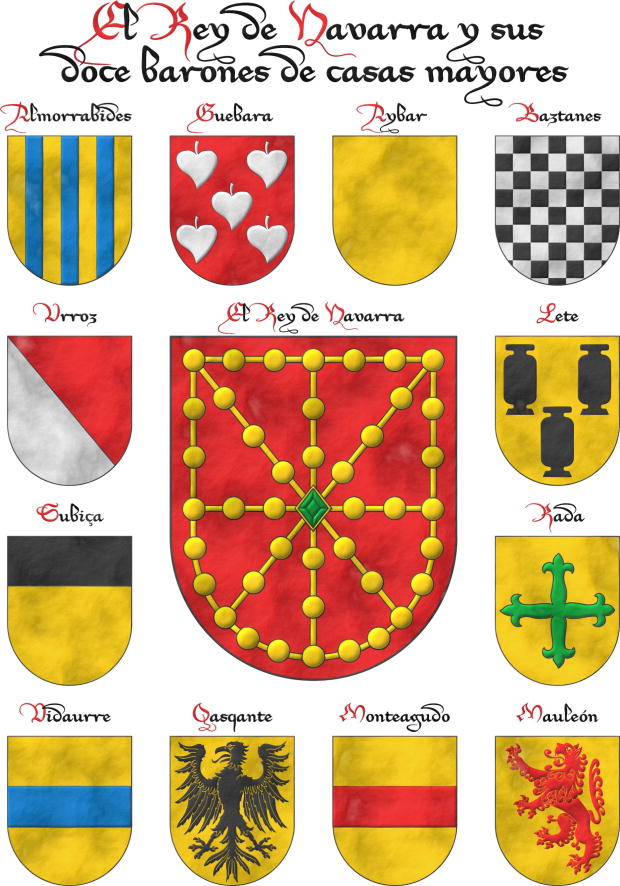
The King of Navarre, at the time of his new and solemn coronation, is raised and lifted up as King by the hands of twelve barons of the greatest and oldest houses of the said Kingdom, and these are the twelve Noblemen who are named on the other side, with their blazons and coats of arms.
Interpretation and composition of 13 coats of arms that I have created with a parchment-like finish.
A free interpretation, for example, without the central crown over the arms of Navarre, with a different title, written «Navarra» and not «Nabarra», etc., based on the principal plate of [Bosque, J. del; 1540; folio 1 of the numbering of 1613] and with texts taken from the transcription by [Martinena Ruiz, J. J.; 1982; pages 122 and 123].
«Ricohombre», written together, currently means «title that formerly belonged to the highest nobility of Spain», [Real Academia Española; 2001].
Its plural «ricoshombres» is the most commonly used form, but «ricohombres» is also correct and used; and in [Bosque, J. del; 1540] it is written separately, and «honbre» with an «n» before the «b», that is, «ricos honbres».
Blazon keywords: Without divisions, Party per bend, Azure, Gules, Or, Argent, Sable, Vert, Eagle, Chequey, Cross flory, Cross couped, Fess, Chief, Lion, Pale, Poplar leaf, Clay pot and Rampant.
Style keywords: Semi-circular and Old parchment.
Classification: Interpreted and Kingdom of Navarre.
Bearer: Noblemen of Navarre.


Almorrabides of Navarre
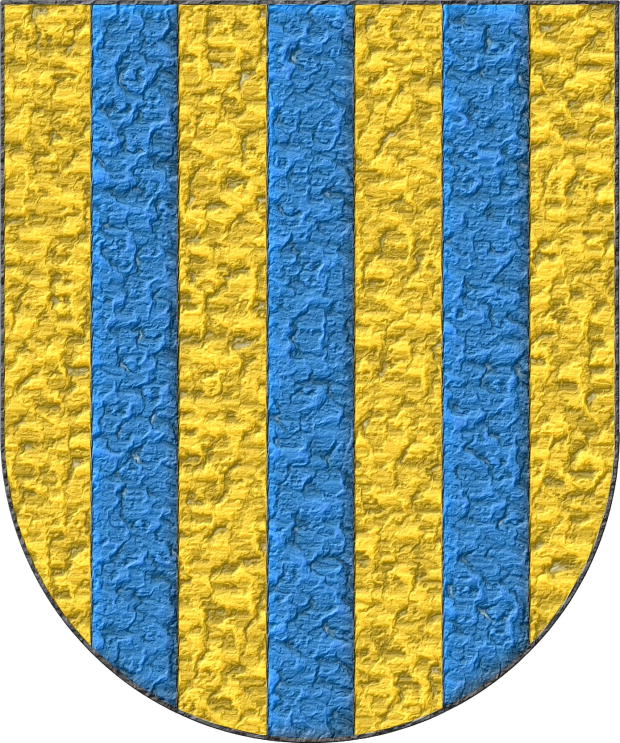
Of the twelve lineages of Noblemen, it is the first, and they bear as arms, on a golden field, three pales Azure.
Or, three Pallets Azure.
Escudo de oro, tres palos de azur.
Coat of arms interpreted with: a semicircular (round) base; the field in flat Or; the pales outlined in Sable and illuminated in Azure enamel; and finished in highly-hammered metal.
Based on the first coat of arms of the «ricoshombres» of Navarre in [Bosque, J. del; 1540; folio 1 of the numbering of 1613] and the text is from the transcription made in [Martinena Ruiz, J. J.; 1982; pages 122 and 123].
Under the title «Los Almorauides» it can also be consulted in [Vega, P. J. de; 1702; folio 1 of the manuscript].
Blazon keywords: Without divisions, Or, Three, Pale and Azure.
Style keywords: Semi-circular, Illuminated, Outlined in sable and Hard metal.
Classification: Interpreted, Personal and Kingdom of Navarre.
Bearer: Almorrabides of Navarre.


Guebara of Navarre
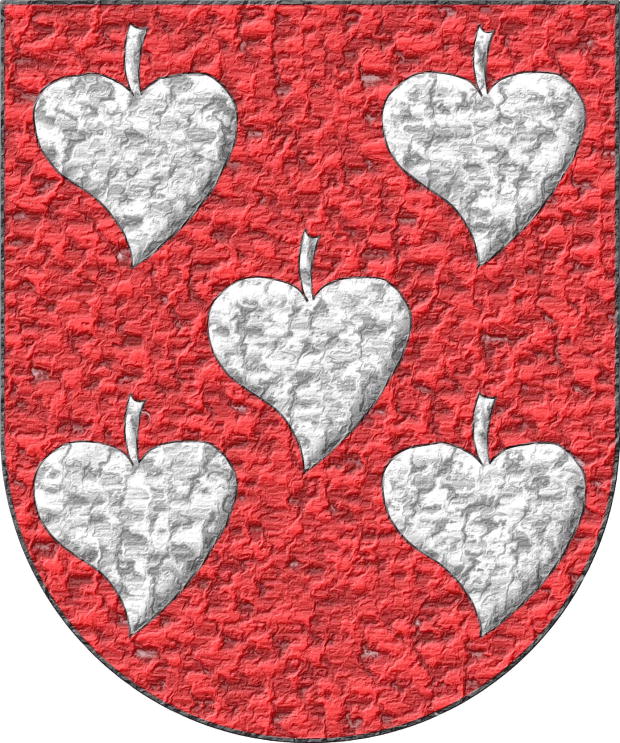
Of the twelve lineages of Noblemen, it is the second, descendant of Álava, the very ancient and powerful one, in which some served under Navarre, and others under the kings of Castile; they bear for arms and insignia, on a field Gules, which is red, five poplar-leaves (panelas) Argent, in the form and design in which this shield is painted.
Gules, five Poplar-leaves Argent, inverted.
Escudo de gules, cinco panelas de plata.
Coat of arms interpreted with: a semicircular (round) base; the field in flat Or; the pales outlined in Sable and illuminated in Azure enamel; and finished in highly-hammered metal.
Interpretation based on the second coat of arms of the «ricoshombres» of Navarre from [Bosque, J. del; 1540; folio 1 of the numbering of 1613] and the accompanying text is from the transcription made in [Martinena Ruiz, J. J.; 1982; pages 122 and 123].
The «panela» is a figure typical of Spanish heraldry [Valero de Bernabé, L.; 2007; page 11]. It is a leaf shaped like a heart with its stalk pointing upward. It could be a leaf of a tree such as, for example, the poplar, although there is no certainty that it is specifically that tree.
With first appearances prior to heraldry on Hispano-Roman tombstones, the «panela» is of Alavese origin, [Menéndez Pidal de Navascués, F.; 1985; page 474], spreading through the Basque-Navarrese region and from there throughout Spain, with the peculiar name «panela», which was initially called «pannella», [Valverde Ogallar, P. B.; 2001; page 532] derived from «pan», [Real Academia Española; 2001].
In the heraldry of other countries, leaves from different trees are used as heraldic symbols, but usually with the stalk pointing downward; therefore I transcribe in this blazon «panelas» ~ «Poplar-leaves, inverted».
[Menéndez Pidal de Navascués, F.; 1985; page 474] states that the «panela» is a natural figure equivalent to the linden leaf in German heraldry, with the stalk downward, and to the water-lily leaf in French heraldry, with the stalk upward; but since these are such different plants, I do not find it suitable to use linden, and even less water-lily, in the English transcription of this Navarrese blazon.
Under the title «Surname of Guebara» it can be consulted in [Vega, P. J. de; 1702; folio 2 of the manuscript].
Blazon keywords: Without divisions, Gules, Poplar leaf and Argent.
Style keywords: Semi-circular, Illuminated, Outlined in sable and Hard metal.
Classification: Interpreted, Personal and Kingdom of Navarre.
Bearer: Guebara of Navarre.


Aybar of Navarre
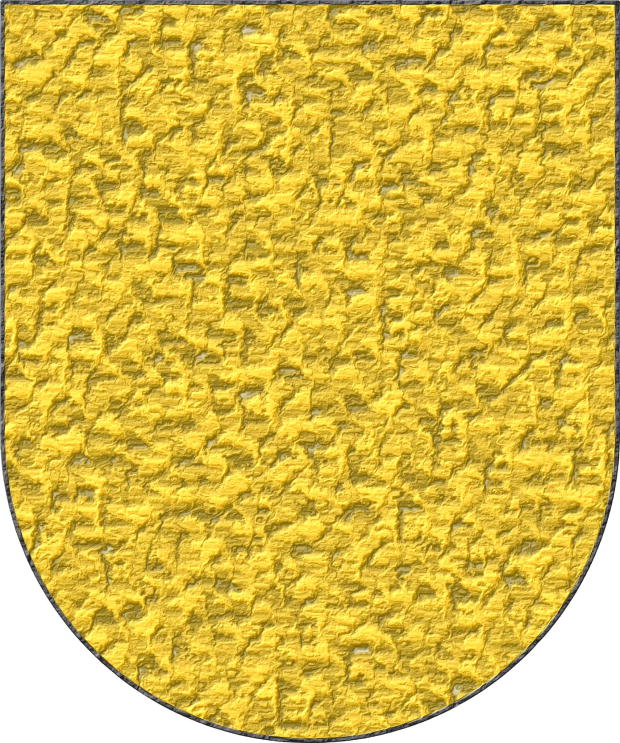
Of the twelve lineages of Noblemen, they are the third great and ancient barony, where the first King of Aragon had his mother; they make a shield of Or without any mixture of colour or device, but a field of gold as painted in this shield.
Or.
Escudo de oro.
A coat of arms that leaves little room for interpretation, which I have recreated with: a semicircular (round) base; the field in flat Or; and finished in highly-hammered metal.
Based on the third coat of arms of the «ricoshombres» of Navarre from [Bosque, J. del; 1540; folio 1 of the numbering of 1613] and the text is from the transcription made in [Martinena Ruiz, J. J.; 1982; pages 122 and 123].
Under the title «Surname of Aybar» it can also be consulted in [Vega, P. J. de; 1702; folio 3 of the manuscript].
Blazon keywords: Without divisions and Or.
Style keywords: Semi-circular, Illuminated, Outlined in sable and Hard metal.
Classification: Interpreted, Personal and Kingdom of Navarre.
Bearer: Aybar of Navarre.


Baztanes of Navarre
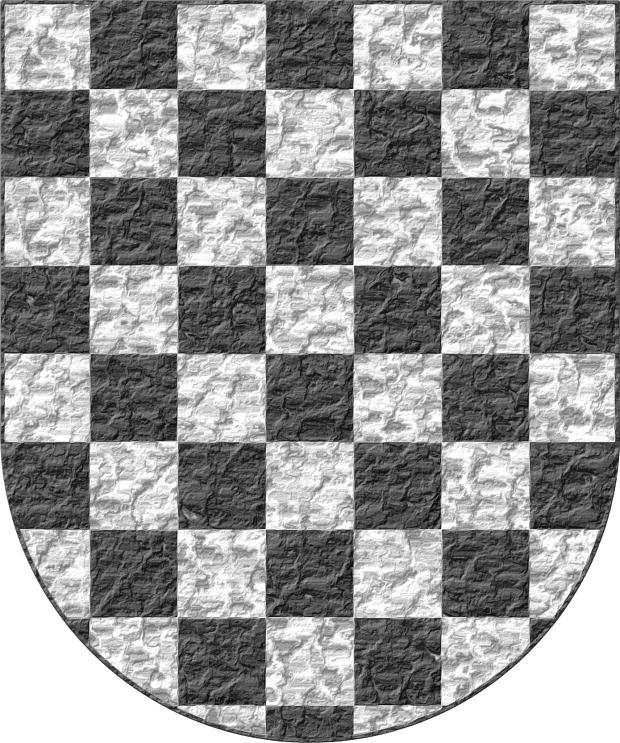
Of the twelve lineages of Noblemen, it is the fourth, and they bear as arms a chessboard, that is, a field chequy Argent and Sable, which is black, in the same form and design as this shield is now painted.
Chequey Argent and Sable.
Escudo ajedrezado de plata y sable.
Coat of arms recreated with: a semicircular (round) base; the field in flat Argent; the chequy or checky pattern illuminated in Sable; and finished in highly-hammered metal.
Coat of arms based on the fourth of the Navarrese «ricoshombres» from [Bosque, J. del; 1540; folio 1 of the numbering of 1613], but, unlike the original, adjusting the height of each square to its width so that they are perfect squares, since in Juan del Bosque’s version—actually in its copy, because the original was stolen—they appear somewhat narrow and elongated. The text heading this article is taken from the transcription made by [Martinena Ruiz, J. J.; 1982; pages 122 and 123].
Under the title «Surname of Baztan» it can also be consulted in [Vega, P. J. de; 1702; folio 4 of the manuscript], although in this case the numbering is not clearly legible; it is the folio following 3, preceding the one also numbered 4 but marked with a letter B, which in turn is followed by folio 6, the number 5 being missing — though not folio 5, which would be 4B.
Baztanes and the Valley of Baztan are mentioned in [Garaycoa Raffo, L.; 2011; pages 8, 29, 30, 33, 37, and 38].
The geometric construction of this coat of arms can be found in [Messía de la Cerda y Pita, L.; 1990; page 108].
Blazon keywords: Without divisions, Or, Chequey and Sable.
Style keywords: Semi-circular, Illuminated and Hard metal.
Classification: Interpreted, Personal and Kingdom of Navarre.
Bearer: Baztanes of Navarre.


Urroz of Navarre
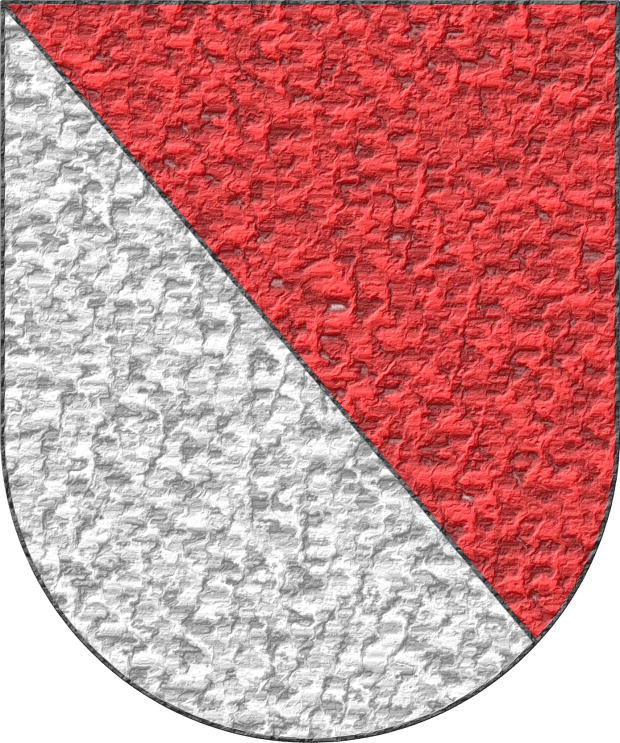
De los doce linajes de Ricos Hombres el quinto es la buena villa de Urroz, la torre blanca; y goza en armas un escudo partido por medio, de lo alto ata baxo, a manera de banda, desta forma e deuisas que en este escudo está de presente pintado.
Party per bend: 1 Gules; 2 Argent.
Escudo tronchado: 1o de gules; 2o de plata.
Coat of arms with poco margen for the interpretación con: la base of semicircular (round); el field of tintas planas of Gules and Argent; y con a finish of metal muy batido.
Coat of arms basado in the 5o of los «ricoshombres» of Navarra de [Bosque, J. del; 1540; folio 1o of the numeración of 1613]. El texto previo a su blasón está extraído of the transcripción realizada por [Martinena Ruiz, J. J.; 1982; páginas 122 and 123].
Bajo the título «Apellido of Vrroz» también puede consultarse en [Vega, P. J. de; 1702; folio 4B of the manuscrito], estando the 4 in the esquina superior izquierda and the B in the base of the coat of arms. Este folio tendría that estar numerado with a 5.
Blazon keywords: Party per bend, Gules and Sable.
Style keywords: Semi-circular, Plain tincture and Hard metal.
Classification: Interpreted, Personal and Kingdom of Navarre.
Bearer: Urroz of Navarre.


Lete of Navarre
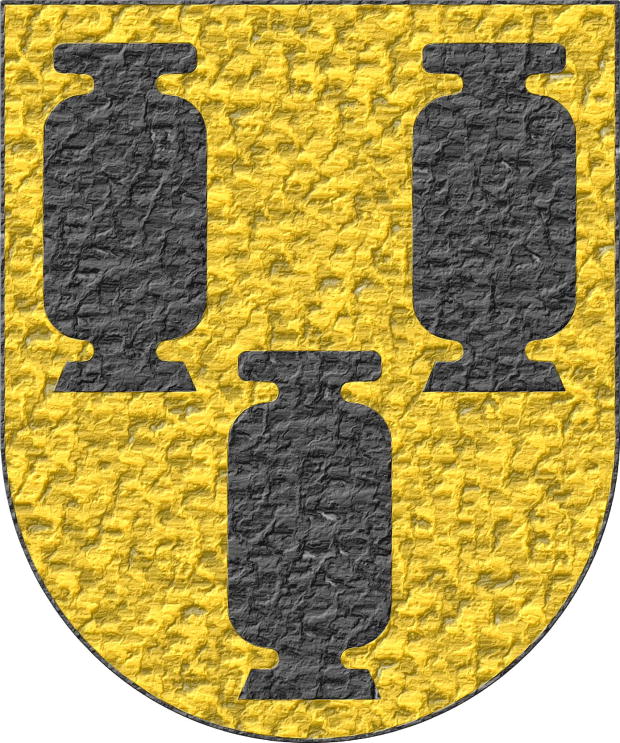
Of the twelve lineages of Noblemen, the sixth is that of Lete, from which descended Don Juan Corbarán de Let: they bear as arms, on a field Or, three pots shaped like cauldrons, slightly elongated, as painted in this shield.
Or, three Fleshpot Sable.
Escudo de oro, tres potes de sable.
Coat of arms interpreted with: a semicircular (round) base; the field in flat Or metal; the three pots illuminated in Sable with vertical, but not horizontal symmetry; and finished in highly-hammered metal.
It is not easy to find in English a similar figure:
- it could be considered «pote» ~ «pot», although perhaps «pot» is too generic,
- another possibility is «pote» ~ «fleshpot», which, although usually represented with three legs instead of a base and with two handles, is the one I tend to prefer,
- the English term «cauldron», but this corresponds to our «caldero» ~ «cauldron».
Coat of arms based on the sixth of the Navarrese «ricoshombres» from [Bosque, J. del; 1540; folio 1 of the numbering of 1613]. The text heading this article is taken from the transcription made by [Martinena Ruiz, J. J.; 1982; pages 122 and 123].
Although I have not found any reference about it, it could be considered that originally they might have been canting arms and that these three «potes» could have been milk pots, in reference to their bearers «Lete».
Under the title «Surname of Let» it can also be consulted in [Vega, P. J. de; 1702; folio 6 of the manuscript], although the number has been altered, possibly having been a 5 and perhaps interpreted as an 8, it is deduced by being placed after folio 7.
Blazon keywords: Without divisions, Or, Clay pot and Sable.
Style keywords: Semi-circular, Illuminated and Hard metal.
Classification: Interpreted, Personal, Kingdom of Navarre and Canting.
Bearer: Lete of Navarre.


Subiça of Navarre
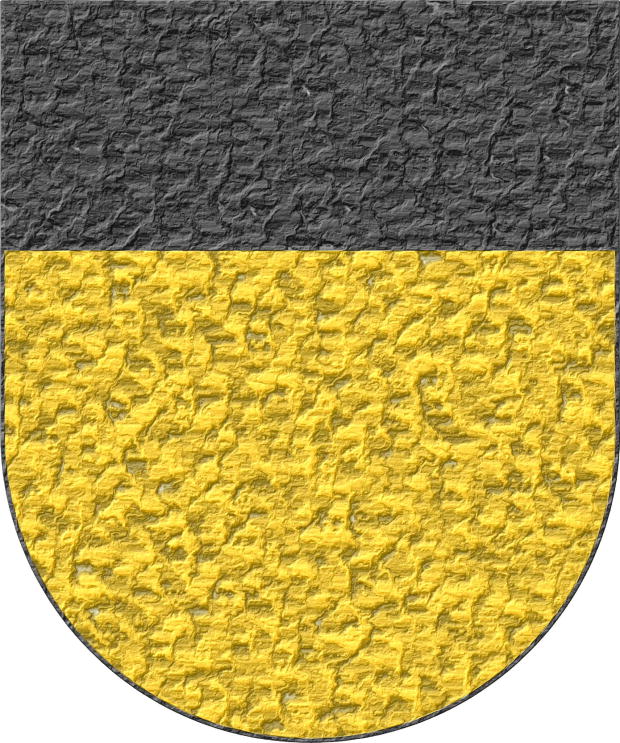
Of the twelve lineages of Noblemen, the seventh is Subiça, and bears as arms a shield Or, with a chief Sable at the upper part of the shield, in the same manner as painted in this one.
Or; a chief Sable.
Escudo de oro; el jefe de sable.
Coat of arms interpreted with: a semicircular (round) base; the field in flat Or metal; the chief in flat Sable; and the whole finished in highly-hammered metal.
Coat of arms based on the seventh of the Navarrese «ricoshombres» from [Bosque, J. del; 1540; folio 1 of the numbering of 1613]. The text heading it is taken from the transcription made by [Martinena Ruiz, J. J.; 1982; pages 122 and 123].
Under the title «Surname of Cubiza» these armorial bearings can be consulted in [Vega, P. J. de; 1702; folio 7 of the manuscript].
Blazon keywords: Without divisions, Or, Chief and Sable.
Style keywords: Semi-circular, Plain tincture and Hard metal.
Classification: Interpreted, Personal and Kingdom of Navarre.
Bearer: Subiça of Navarre.

Continue with: Rada of Navarre.
-
Language
-
Categories of heraldry
-
Divisions of the field
- Without divisions
- Party per pale
- Party per fess
- Party per bend
- Party per bend sinister
- Tierce
- Tierce sinister
- Tierced per pale
- Tierced per fess
- Tierced per bend
- Tierced pallwise inverted
- Quarterly
- Quarterly per saltire
- Gyronny
- Party per fess, the chief per pale
- Party per pale, the sinister per fess
- Party per fess, the base per pale
- Party per pale, the dexter per fess
- Chapé
- Chaussé
- Embrassé
- Contre-embrassé
- Party per chevron
- Enté
- Enté en point
- Flanched
-
Metals
-
Colours
-
Furs
-
Other tinctures
-
Ordinaries and sub-ordinaries
-
Diminutives of the ordinaries
-
Other charges
-
Inanimate charges from Nature
Atom, Crescent, Diamond, Emerald, Estoile, Increscent, Lightning flash, Moon, Mount, Mullet, Mullet of four points, Orbital, Plough of Ursa Major, Rainbow, Ray of the sun, River, Sea, Snowflake, Sun, Sun in splendour, Sun of May, Trimount and Water.
-
Vegetal charges from Nature
Acorn, Apple, Apple tree, Ash, Bluebonnet, Camellia, Chrysanthemum, Cinquefoil, Cornflower, Dogwood flower, Double rose, Elm, Fleur de lis, Flower, Holm oak, Hop cone, Kapok tree, Laurel, Lily, Linden, Lotus flower, Madonna lily, Oak, Olive tree, Palm tree, Pomegranate, Poplar leaf, Rose, Shamrock, Sunflower, Thistle, Tree, Tulip, Vine and Wheat.
-
Animal charges from Nature
Badger, Bald eagle, Barbel, Barn owl, Bear, Beaver, Beetle, Bighorn sheep, Blackbird, Boar, Brach hound, Bull, Doe, Dog, Dolphin, Dove, Eagle, Elephant, Falcon, Fish, Flame, Fly, Fox, Frog, Goat, Goldfinch, Goose, Heron, Horse, Hummingbird, Jaguar, Lark, Leopard, Lion, Lion passant, Lion rampant guardant, Lioness, Lynx, Male figure, Martlet, Merino ram, Owl, Panther, Parrot, Peacock, Pelican, Pelican in her piety, Puffin, Quetzal, Raven, Roe deer, Rooster, Savage, Seagull, Serpent, She-wolf, Stag, Starling, Tyger, Vulture, Warren hound and Wolf.
-
Parts of natural charges
Arm, Beak, Branch, Caboshed, Chest, Claw, Covert, Dorsal fin, Eagle claw, Ermine spot, Escallop, Feather, Foot (palmiped), Foreleg, Forepaw, Hand, Head, Heart, Hoof, Leaf, Neck, Ostrich feather, Palm frond, Paw, Roe deers' attires, Shoulder, Sprig, Stags' attires, Stem, Swallow-tail, Tail, Tail addorsed, Tail fin, Talon, Tooth, Trunk, Trunk (elephant), Two hands clasped, Two wings in vol, Udder, Wheat spike, Wing and Wrist.
-
Artificial charges
Ace of spades, Anchor, Anvil, Arch, Arm vambraced, Armillary sphere, Arrow, Axe, Bell, Bell tower, Beret, Bonfire, Book, Bookmark, Bow, Bridge, Broken, Buckle, Cannon, Cannon dismounted, Cannon port, Carbuncle, Castle, Celtic Trinity knot, Chain, Chess rooks, Church, Clarion, Clay pot, Closed book, Club, Comb, Compass rose, Conductor's baton, Cord, Covered cup, Crozier, Crucible, Cuffed, Cup, Cyclamor, Dagger, Double vajra, Drum, Ecclesiastical cap, Fanon, Federschwert, Fleam, Four crescents joined millsailwise, Galician granary, Garb, Gauntlet, Geometric solid, Grenade, Halberd, Hammer, Harp, Host, Hourglass, Key, Key ward, Knight, Knot, Lantern, Letter, Line, Loincloth, Menorah, Millrind, Millstone, Millwheel, Monstrance, Mortar, Mullet of six points pierced, Nail, Non-classic artifact, Norman ship, Number, Oar, Oil lamp, Open book, Page, Pair of scales, Parchment, Pestle, Piano, Plough share, Polish winged hussar, Port, Portcullis, Potent, Quill, Ribbon, Rosette of acanthus leaves, Sabre, Sackbut, Sail, Scroll, Scythe, Sheaf of tobacco, Ship, Skirt, Spear, Spear's head, Stairway, Star of David, Step, Sword, Symbol, Tetrahedron, Torch, Tower, Trident, Trumpet, Turret, Two-handed sword, Wagon-wheel, Water-bouget, Wheel, Winnowing fan and With a turret.
-
Immaterial charges
Angel, Archangel, Basilisk, Dragon, Dragon's head, Garuda, Golden fleece, Griffin, Heart enflamed, Mermaid, Our Lady of Mercy, Ouroboros, Paschal lamb, Pegasus, Phoenix, Sacred Heart of Jesus, Saint George, Sea-griffin, Trinity, Triton, Unicorn, Winged hand and Wyvern.
-
External elements
-
Heraldic creations
-
References
-
Formats
-
Keywords on this page
Chequey, Almorrabides of Navarre, Old parchment, Aybar of Navarre, Azure, Baztanes of Navarre, Cross flory, Cross couped, Outlined in sable, Fess, Personal, Guebara of Navarre, Gules, Illuminated, Interpreted, Chief, Lete of Navarre, Lion, Semi-circular, Hard metal, Noblemen of Navarre, Or, Pale, Poplar leaf, Canting, Argent, Without divisions, Clay pot, Rada of Navarre, Rampant, Kingdom of Navarre, Sable, Vert, Subiça of Navarre, Plain tincture, Three, Party per bend, Urroz of Navarre and Eagle.